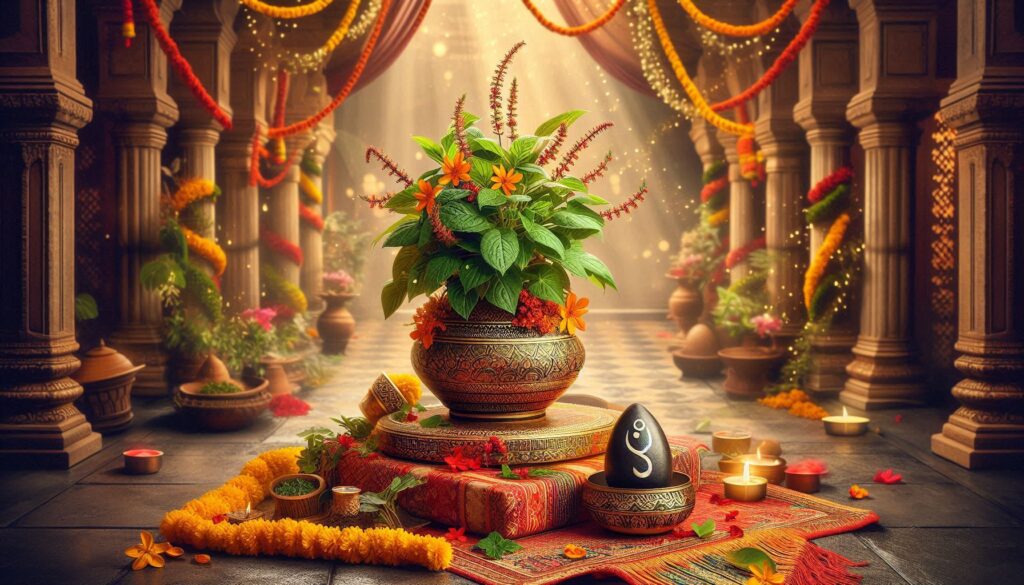Tulsi Vivah is a highly revered and sacred ritual in Hinduism, celebrated on the Ekadashi (11th lunar day) of the bright half of the Kartik month, known as Prabodhini Ekadashi. This day is also called Dev Uthani Ekadashi, as it marks the end of Lord Vishnu’s four-month-long cosmic slumber (Chaturmas) and his return to preside over the cosmic order. Tulsi Vivah holds a significant place, especially in North India, where it is celebrated with great devotion and enthusiasm. This ritual involves the symbolic marriage of the holy Tulsi plant (sacred basil, beloved of Lord Vishnu) to Shaligram (a form of Lord Vishnu), marking the start of the wedding and auspicious season in Hindu culture.
Timing of Tulsi Vivah
According to the Hindu calendar, the Dwadashi Tithi of Kartik month will begin on Tuesday, November 12, 2024, at 4:02 PM, and it will end on Wednesday, November 13, 2024, at 1:01 PM. Based on the Panchang, the Tulsi Vivah festival will be celebrated on November 13 this year.
Significance of Tulsi Vivah
Tulsi Vivah is considered an extremely auspicious ritual. It is believed that performing Tulsi Vivah blesses couples with happiness, prosperity, peace, and good fortune in married life. It is also believed to eliminate difficulties and bring blessings from Lord Vishnu and Tulsi Mata.
From a cultural standpoint, Tulsi Vivah highlights the deep connection between Hindu rituals and environmental respect, as Tulsi holds immense medicinal value and is highly regarded in Ayurveda. This celebration reinforces the spiritual and ecological importance of the Tulsi plant in Hindu tradition.
Story Behind Tulsi Vivah
According to the legends associated with Tulsi Vivah, Tulsi’s original name was Vrinda, who was the devoted wife of the demon king Jalandhar. Through her chaste life and devotional practices, Vrinda made Jalandhar invincible and immortal, making him undefeatable for the gods. The gods prayed to Lord Vishnu for help, and Vishnu, through divine strategy, broke Vrinda’s steadfast chastity. This led to Jalandhar’s demise. Grieving the loss of her husband, Vrinda cursed Lord Vishnu to turn into stone. This is why Vishnu manifested as the Shaligram stone. Later, to console Vrinda, Lord Vishnu blessed her by reincarnating her as the sacred Tulsi plant and promised to always remain with her in this form. Thus, it is believed that any worship of Lord Vishnu is incomplete without Tulsi. Tulsi Vivah, therefore, symbolizes the union of Tulsi and Lord Vishnu in his Shaligram form.
Worship Mantra of Mother Tulsi
Tulsi Shrimahalakshmi Vidya Vidya Yashaswini.
Dharmaya Dharmananna Devi Devidevman: Priya.
You get the threads of devotion and you get the feet of Vishnu.
Tulsi Bhoomahalakshmi: Padmini Shri Harpriya.
Mantra of Lord Vishnu
Om Namoh Narayanaya Namah
Om Namoh Bhagvate Vasudevay Namah
The Rituals of Tulsi Vivah
The Tulsi Vivah ceremony follows specific steps:
- Decoration of Tulsi Plant: The Tulsi plant is adorned with new garments, jewelry, and decorative items.
- Installation of Shaligram: Shaligram (symbolizing Lord Vishnu) is placed near the Tulsi plant and is similarly decorated with fine attire and ornaments.
- Ganesh Puja: The ritual begins with an invocation to Lord Ganesha for the removal of obstacles.
- Worship of Tulsi: The Tulsi plant is ceremonially bathed with holy items such as roli (vermilion), rice, turmeric, and water.
- Marriage Ceremony: The marriage rituals, similar to those performed in a Hindu wedding, are conducted for Tulsi and Shaligram, including tying the sacred thread (mangalsutra), applying kumkum, and offering rice grains.
- Chanting of Vedic Mantras: Sacred Vedic mantras are chanted, followed by the aarti (ritual of light) for Lord Vishnu and Tulsi Mata.
- Distribution of Prasad: The ceremony concludes with the distribution of prasad, and the devotees listen to the story of Tulsi Vivah.
Do not offer water to Tulsi plant
During the puja, stand facing south with rice in your hand and offer it to Lord Vishnu. Pandit ji further said that on the day of Tulsi Vivah, special care should be taken not to offer water to Tulsi because on this day the Goddess keeps a waterless fast for Lord Vishnu.
Circumambulate the Tulsi plant as much as possible.
All women should use sesame seeds in Tulsi Ji's marriage. Lord Shiva's Shaligram should be placed in the pot in which Mother Tulsi has planted the plant and sesame seeds should be offered. During Tulsi Vivah, the Tulsi plant should be rotated 11 times. This can maintain happiness in married life.
